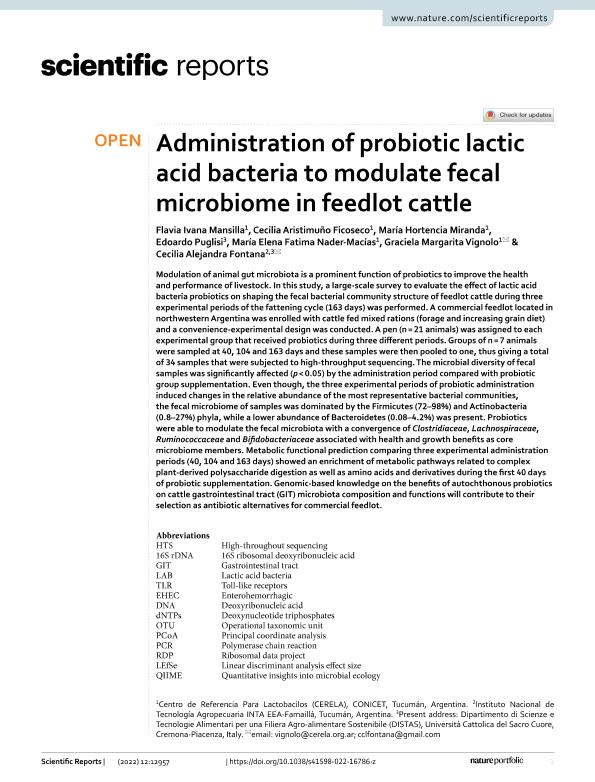Mostrar el registro sencillo del ítem
dc.contributor.author
Mansilla, Flavia Ivana

dc.contributor.author
Aristimuño Ficoseco, Maria Cecilia

dc.contributor.author
Miranda, Maria Hortencia

dc.contributor.author
Puglisi, Edoardo

dc.contributor.author
Nader, Maria Elena Fatima

dc.contributor.author
Vignolo, Graciela Margarita

dc.contributor.author
Fontana, Cecilia Alejandra

dc.date.available
2023-07-31T12:21:05Z
dc.date.issued
2022-07
dc.identifier.citation
Mansilla, Flavia Ivana; Aristimuño Ficoseco, Maria Cecilia; Miranda, Maria Hortencia; Puglisi, Edoardo; Nader, Maria Elena Fatima; et al.; Administration of probiotic lactic acid bacteria to modulate fecal microbiome in feedlot cattle; Nature Publishing Group; Scientific Reports; 12; 1; 7-2022; 1-16
dc.identifier.issn
2045-2322
dc.identifier.uri
http://hdl.handle.net/11336/206106
dc.description.abstract
Modulation of animal gut microbiota is a prominent function of probiotics to improve the health and performance of livestock. In this study, a large-scale survey to evaluate the effect of lactic acid bacteria probiotics on shaping the fecal bacterial community structure of feedlot cattle during three experimental periods of the fattening cycle (163 days) was performed. A commercial feedlot located in northwestern Argentina was enrolled with cattle fed mixed rations (forage and increasing grain diet) and a convenience-experimental design was conducted. A pen (n = 21 animals) was assigned to each experimental group that received probiotics during three different periods. Groups of n = 7 animals were sampled at 40, 104 and 163 days and these samples were then pooled to one, thus giving a total of 34 samples that were subjected to high-throughput sequencing. The microbial diversity of fecal samples was significantly affected (p < 0.05) by the administration period compared with probiotic group supplementation. Even though, the three experimental periods of probiotic administration induced changes in the relative abundance of the most representative bacterial communities, the fecal microbiome of samples was dominated by the Firmicutes (72–98%) and Actinobacteria (0.8–27%) phyla, while a lower abundance of Bacteroidetes (0.08–4.2%) was present. Probiotics were able to modulate the fecal microbiota with a convergence of Clostridiaceae, Lachnospiraceae, Ruminococcaceae and Bifidobacteriaceae associated with health and growth benefits as core microbiome members. Metabolic functional prediction comparing three experimental administration periods (40, 104 and 163 days) showed an enrichment of metabolic pathways related to complex plant-derived polysaccharide digestion as well as amino acids and derivatives during the first 40 days of probiotic supplementation. Genomic-based knowledge on the benefits of autochthonous probiotics on cattle gastrointestinal tract (GIT) microbiota composition and functions will contribute to their selection as antibiotic alternatives for commercial feedlot.
dc.format
application/pdf
dc.language.iso
eng
dc.publisher
Nature Publishing Group

dc.rights
info:eu-repo/semantics/openAccess
dc.rights.uri
https://creativecommons.org/licenses/by/2.5/ar/
dc.subject
LACTIC ACID BACTERIA
dc.subject
PROBIOTICOS
dc.subject
FEEDLOT CATTLE
dc.subject
METAGENOMICA
dc.subject.classification
Biología Celular, Microbiología

dc.subject.classification
Ciencias Biológicas

dc.subject.classification
CIENCIAS NATURALES Y EXACTAS

dc.title
Administration of probiotic lactic acid bacteria to modulate fecal microbiome in feedlot cattle
dc.type
info:eu-repo/semantics/article
dc.type
info:ar-repo/semantics/artículo
dc.type
info:eu-repo/semantics/publishedVersion
dc.date.updated
2023-07-07T19:01:59Z
dc.journal.volume
12
dc.journal.number
1
dc.journal.pagination
1-16
dc.journal.pais
Reino Unido

dc.journal.ciudad
Londres
dc.conicet.avisoEditorial
institutional afliations.
Open Access Tis article is licensed under a Creative Commons Attribution 4.0 International
License, which permits use, sharing, adaptation, distribution and reproduction in any medium or
format, as long as you give appropriate credit to the original author(s) and the source, provide a link to the
Creative Commons licence, and indicate if changes were made. Te images or other third party material in this
article are included in the article’s Creative Commons licence, unless indicated otherwise in a credit line to the
material. If material is not included in the article’s Creative Commons licence and your intended use is not
permitted by statutory regulation or exceeds the permitted use, you will need to obtain permission directly from
the copyright holder. To view a copy of this licence, visit http://creativecommons.org/licenses/by/4.0/.
dc.description.fil
Fil: Mansilla, Flavia Ivana. Consejo Nacional de Investigaciones Científicas y Técnicas. Centro Científico Tecnológico Conicet - Tucumán. Centro de Referencia para Lactobacilos; Argentina
dc.description.fil
Fil: Aristimuño Ficoseco, Maria Cecilia. Consejo Nacional de Investigaciones Científicas y Técnicas. Centro Científico Tecnológico Conicet - Tucumán. Centro de Referencia para Lactobacilos; Argentina
dc.description.fil
Fil: Miranda, Maria Hortencia. Consejo Nacional de Investigaciones Científicas y Técnicas. Centro Científico Tecnológico Conicet - Tucumán. Centro de Referencia para Lactobacilos; Argentina
dc.description.fil
Fil: Puglisi, Edoardo. Università Cattolica del Sacro Cuore; Italia
dc.description.fil
Fil: Nader, Maria Elena Fatima. Consejo Nacional de Investigaciones Científicas y Técnicas. Centro Científico Tecnológico Conicet - Tucumán. Centro de Referencia para Lactobacilos; Argentina
dc.description.fil
Fil: Vignolo, Graciela Margarita. Consejo Nacional de Investigaciones Científicas y Técnicas. Centro Científico Tecnológico Conicet - Tucumán. Centro de Referencia para Lactobacilos; Argentina
dc.description.fil
Fil: Fontana, Cecilia Alejandra. Instituto Nacional de Tecnologia Agropecuaria. Centro Regional Tucuman-santiago del Estero. Estacion Experimental.agropecuaria Famailla. Agencia de Extension Rural S M de Tucuman.; Argentina. Università Cattolica del Sacro Cuore; Italia
dc.journal.title
Scientific Reports
dc.relation.alternativeid
info:eu-repo/semantics/altIdentifier/url/https://www.nature.com/articles/s41598-022-16786-z
dc.relation.alternativeid
info:eu-repo/semantics/altIdentifier/doi/https://doi.org/10.1038/s41598-022-16786-z
Archivos asociados
